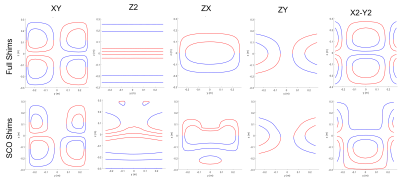5025
Spherical Harmonic Active Shim Set Design for a Shoulder Cut-out MRI Platform1Western University, London, ON, Canada
Synopsis
This simulation and electromagnetic design work explored the development of an active second order spherical harmonic shim set for eddy current compensation in a shoulder cut-out head and neck imaging platform. While the small radius shoulder cut-out shims can be driven faster and stronger than the larger radius complete cylinder shims they suffer in homogeneity and eddy current compensation. This difference in compensation is minimized with the addition of two purpose designed eddy current compensation coils.
INTRODUCTION
Previously1, we have presented designs for actively shielded transverse gradient coils with shoulder cut-outs (SCO) for use in a compact head and neck platform. These designs not only utilize an asymmetric gradient configuration but also implement the field gradients along rotated cartesian axes (d1- and d2-gradients). While the primary coils have a small radius and shoulder cut-outs, the shield coils are pushed further outside the patients shoulders allowing them to be complete cylinders. These factors will have an influence on the complexity of the induced eddy currents and may require higher order eddy current compensation than can be accomplished using gradient pre-emphasis alone. This can be accomplished dynamically using the resistive spherical harmonic shim coils which are traditionally used to correct for inhomogeneities in the magnetic field environment. In this work we explored the relative trade-offs in implementing smaller radii SCO shims versus larger radii full cylinder shims for implementation within the SCO gradient platform.METHODS
An in-house MATLAB mesh generation software was used for design of computational meshes for use in an in-house MATLAB boundary element method solver2. The SCO set was designed with a radius of 0.25 m with a rectangular portion of 0.225 m along z and 0.15 m along y as the SCO portion to fit patient shoulders. The SCO portion was implemented by setting the resistivity in that region to have too high of a cost associated with placing wires in that region such that no wires were placed. The full cylindrical set was designed with a radius of 0.27 m and both had a maximum allowable length of 0.6 m. For each geometry five shim axes were designed: Z2, ZX, ZY, XY, and X2-Y2. The final selected designs for each configuration were chosen to maximize slew rate and minimize inhomogeneity in the spherical harmonic field. To evaluate eddy current compensation, we used wire patterns from our X-Mode gradient coils (d1- and d2-gradients) and with the assumption that the gradient coils are driven by a Heavyside step function determined the initial induced eddy current, using a stream-function approach3, in a computational bore surface (r = 0.3 m , L=1.0 m). A linear combination of the d1, d2-Gradients and spherical harmonic shim fields was used to compensate for the spherical harmonics within the eddy current field and the pre- and post-compensation profiles were fit to spherical harmonics to determine the quality of compensation. Lastly, to increase performance two additional coils were designed for each configuration using the eddy current field as field targets in the design process.RESULTS
The selected shim coils for each configuration are shown in Figure 1 with their corresponding electromagnetic profiles given in Table 1. Figure 2 shows the spherical harmonic decomposition of the eddy current field pre-compensation and the residual field post-compensation with and without the extra coils. The additional designed coils designed using the eddy current field data are shown in Figure 3.DISCUSSION
The smaller radius of the SCO shim set leads to an increase in overall slew-rate and field efficiency compared to the complete cylinder set. However, there is a noticeable decrease in shim homogeneity measured both by the magnitude of the difference between the produced and ideal field as well as the maximum field deviation both calculated over a 0.20 m diameter sphere. This loss of homogeneity is evident in the post-compensated field profiles of the SCO where there is poorer performance. However, with the inclusion of an extra pair of compensation coils the SCO coils perform closer to the complete cylinder set with the benefit of increased efficiency and slew-rate. This is most noticeable in the X2-Y2 case where compensation increased the contribution of that higher order term. It is important to note that a design study on the extra compensation coils was not performed and increased performance may be possible through a complete investigation. Dynamic eddy current compensation as is the goal in this work is important as the complexity of gradient coils increases and higher order terms are found within the eddy current field profile.CONCLUSION
The SCO set of shims are more efficient and can be slewed at higher slew rates however they perform worse than the full cylinder set in compensating for spherical harmonics in the eddy current field. This difference can be improved on by adding an additional two shims which are designed using the eddy current field data which improves the spherical harmonic compensation in the eddy current field.Acknowledgements
The authors acknowledge financial support from NSERC and the Ontario Research FundReferences
1. Lessard EJ et al. Proc. Intl. Soc. Mag. Reason. Med. 28 (2020) Abstract #4247
2. Harris CT et al. Concepts Magn. Reson., 41B: 120-129 (2012)
3. Peeren GN, Technische Universiteit Eindhoven PhD Thesis (2003)
Figures

Figure 1: Spherical Harmonic Active Shim Wire Patterns
Color indicates direction of current with respect to azimuthal direction


Figure 3: Eddy Current Compensation Coils
Color indicates direction of current with respect to azimuthal direction